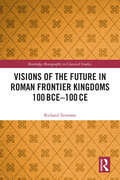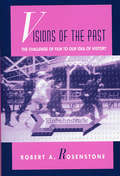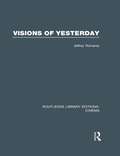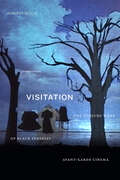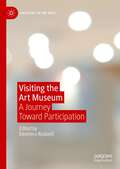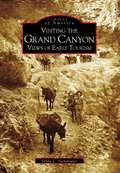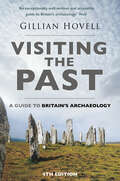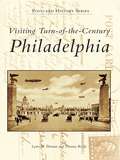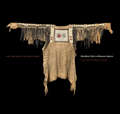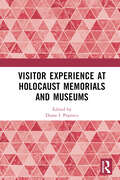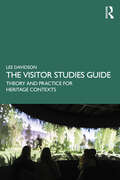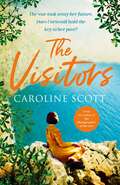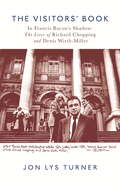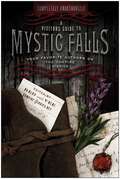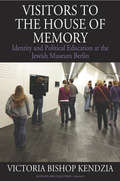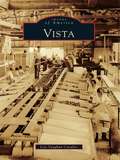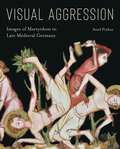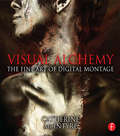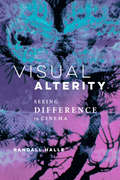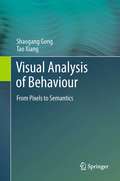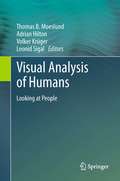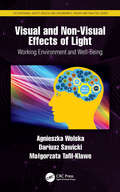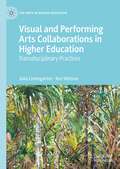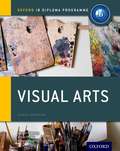- Table View
- List View
Visions of the Future in Roman Frontier Kingdoms 100 BCE–100 CE (Routledge Monographs in Classical Studies)
by Richard TeversonThis is the first book-length exploration of the ways art from the edges of the Roman Empire represented the future, examining visual representations of time and the role of artwork in Roman imperial systems.This book focuses on four kingdoms from across the empire: Cottius’s Alpine kingdom in the north, King Juba II’s Mauretania in the south-west, Herodian Judea in the east, and Kommagene to the north-east. Art from the imperial frontier is rarely considered through the lens of the aesthetics of time, and Roman provincial art and the monuments of allied rulers are typically interpreted as evidence of the interaction between Roman and local identities. In this interdisciplinary study, which explores statues, wall paintings, coins, monuments, and inscriptions, readers learn that these artworks served as something more: they were created to represent the futures that allied rulers and their people foresaw. The pressure of Roman imperialism drove patrons and artists on the empire’s borders to imbue their creations with increasingly sophisticated ideas about the future, as they wrestled with consequential decisions made under periods of intense political pressure.Comprehensively illustrated and providing an important new approach to Roman material culture at the edge of empire, Visions of the Future in Roman Frontier Kingdoms 100 BCE–100 CE is suitable for students and scholars working on Rome and its frontiers, as well as Roman material culture more broadly, and those studying the aesthetics of time in art and art history.
Visions of the Past: The Challenge of Film to Our Idea of History
by Robert A. RosenstoneCan filmed history measure up to written history? What happens to history when it is recorded in images, rather than words? Can images convey ideas and information that lie beyond words? Taking on these timely questions, Robert Rosenstone pioneers a new direction in the relationship between history and film. Rosenstone moves beyond traditional approaches, which examine the history of film as art and industry, or view films as texts reflecting their specific cultural contexts. This essay collection makes a radical venture into the investigation of a new concern: how a visual medium, subject to the conventions of drama and fiction, might be used as a serious vehicle for thinking about our relationship with the past. Rosenstone looks at history films in a way that forces us to reconceptualize what we mean by "history." He explores the innovative strategies of films made in Africa, Latin America, Germany, and other parts of the world. He journeys into the history of film in a wide range of cultures, and expertly traces the contours of the postmodern historical film. In essays on specific films, including Reds, JFK, and Sans Soleil, he considers such issues as the relationship between fact and film and the documentary as visionary truth. Theorists have for some time been calling our attention to the epistemological and literary limitations of traditional history. The first sustained defense of film as a way of thinking historically, this book takes us beyond those limitations.
Visions of Yesterday (Routledge Library Editions: Cinema)
by Jeffrey RichardsFilm is an important source of social history, as well as having been a popular art form from the early twentieth century. This study shows how a society, consciously or unconsciously, is mirrored in its cinema. It considers the role of the cinema in dramatizing popular beliefs and myths, and takes three case studies – American populism, British imperialism, German Nazism – to explain how a nation’s pressures, tensions and hopes come through in its films. Examining the American cinema is accomplished by analysing the careers of three great directors, John Ford, Frank Capra and Leo McCarey, while the British and German cinemas are studied by theme. The analysis of the British Empire as seen in film broke exciting new ground with a pioneering account of ‘the cinema of Empire’ when it was first published in 1973. With full filmographies and a carefully selected bibliography it is an outstanding work of reference and its lively approach makes it a delight to read. Reviews of the original edition: ‘A work of considerable force and considerable wit.’ – Clive James, Observer ‘…a work that is original, mentally stimulating and most pleasurable to read.’ – Focus on Film
Visitation: The Conjure Work of Black Feminist Avant-Garde Cinema
by Jennifer DeClueIn Visitation, Jennifer DeClue shows how Black feminist avant-garde filmmakers draw from historical archives in order to visualize and reckon with violence suffered by Black women in the United States. DeClue argues that these filmmakers—including Kara Walker, Kara Lynch, Tourmaline, and Ja’Tovia Gary—create spaces of mourning and reckoning rather than voyeurism and pornotropy. Through their use of editing, performance, and cinematic experimentation, these filmmakers intervene in the production of Blackness and activate new ways of seeing Black women and telling their stories. Theorizing these films as a form of conjure work, DeClue shows how these filmmakers raise the specters of Black women from the past and invite them to reveal history from their point of view. In so doing, Black feminist avant-garde filmmakers channel spirits that haunt archives and create cinematic arenas for witnessing Black women battling for survival during pivotal and exceedingly violent moments in US history.Duke University Press Scholars of Color First Book Award recipient
Visiting the Art Museum: A Journey Toward Participation (Sociology of the Arts)
by Eleonora RedaelliVisiting the Art Museum: A Journey Toward Participation is a book about the visitor experience. It is written as a companion for visitors to and inside the art museum. The volume engages readers in transforming a common experience, the museum visit, into a sophisticated epistemological inquiry. The study of the visitor experience through an epistemological approach consists of the untangling of the academic disciplines that study and inform each step of this experience: urban studies, architecture, design, art history, art education, and nonprofit management. This journey follows a transformative bottom-up trajectory from experiential to epistemological, and, finally, reveals itself as empowering. The book unfolds as an edited volume, with chapters by different authors who are enthusiastic scholars in each discipline and addresses undergraduate students as citizens, master’s students as professionals, and scholars as teachers and researchers. Each reader will discover a kaleidoscopic world made of ideas, values, and possibilities for participation.
Visiting the Grand Canyon: Early Views of Tourism
by Linda L. StampoulosThe Colorado River began carving a course to create the Grand Canyon some four to six million years ago, but organized tourism to the natural wonder is fairly young, geologically speaking. Getting to the view along and below the rim has not always been as convenient as packing up the family car and hitting the road. The El Tovar Hotel, celebrating its centennial in 2005, had just opened to lodgers when the Canyon was declared a National Monument in 1908. Between the 1890s and the 1920s, horses, mules, river rafts, stagecoaches, and later railroads and automobiles permitted increasing access to the area. Recreation areas, businesses catering to tourists, and federal preservation programs would eventually mark the Grand Canyon as the ultimate American travel destination.
Visiting the Past: A Guide to Britain's Archaeology
by Gillian HovellArchaeology isn’t just for academics and television presenters – it’s for everyone. And it is all around us. Get your boots on and explore Britain’s national and local archaeology sites for yourself with this revised and updated, easy-to-read, fully illustrated guide.Follow our islands’ history in this step-by-step introduction. Discover what life was like from the earliest days of human habitation right through to the world wars. Then get out to visit the best sites and see what features each era left behind for us to find – and find out how to spot archaeology for yourself in the most surprising places.Be warned: you may never look at an empty field, a stone monument or an old building in the same way again!
Visiting Turn-of-the-Century Philadelphia
by Thomas Reilly Lynn M. HomanFrom the 1890s through the 1920s, the postcard was an extraordinarily popular means of communication, and many of the postcards produced during this "golden age" can today be considered works of art. Postcard photographers traveled the length and breadth of the nation snapping photographs of busy street scenes, documenting local landmarks, and assembling crowds of local children only too happy to pose for a picture. These images, printed as postcards and sold in general stores across the country, survive as telling reminders of an important era in America's history. This fascinating new history of Philadelphia at the turn of the century showcases more than two hundred of the best postcards available.
Visiting With the Ancestors: Blackfoot Shirts in Museum Spaces
by Alison K. Brown Laura PeersIn 2010, five magnificent Blackfoot shirts, now owned by the University of Oxford’s Pitt Rivers Museum, were brought to Alberta to be exhibited at the Glenbow Museum, in Calgary, and the Galt Museum, in Lethbridge. The shirts had not returned to Blackfoot territory since 1841, when officers of the Hudson’s Bay Company acquired them. The shirts were later transported to England, where they had remained ever since. Exhibiting the shirts at the museums was, however, only one part of the project undertaken by Laura Peers and Alison Brown. Prior to the installation of the exhibits, groups of Blackfoot people—hundreds altogether—participated in special “handling sessions,” in which they were able to touch the shirts and examine them up close. The shirts, some painted with mineral pigments and adorned with porcupine quillwork, others decorated with locks of human and horse hair, took the breath away of those who saw, smelled, and touched them. Long-dormant memories were awakened, and many of the participants described a powerful sense of connection and familiarity with the shirts, which still house the spirit of the ancestors who wore them. In the pages of this beautifully illustrated volume is the story of an effort to build a bridge between museums and source communities, in hopes of establishing stronger, more sustaining relationships between the two and spurring change in prevailing museum policies. Negotiating the tension between a museum’s institutional protocol and Blackfoot cultural protocol was challenging, but the experience described both by the authors and by Blackfoot contributors to the volume was transformative. Museums seek to preserve objects for posterity. Visiting With the Ancestorsdemonstrates that the emotional and spiritual power of objects does not vanish with the death of those who created them. For Blackfoot people today, these shirts are a living presence, one that evokes a sense of continuity and inspires pride in Blackfoot cultural heritage.
Visitor Experience at Holocaust Memorials and Museums
by Diana I. PopescuVisitor Experience at Holocaust Memorials and Museums is the first volume to offer comprehensive insights into visitor reactions to a wide range of museum exhibitions, memorials, and memory sites. Drawing exclusively upon empirical research, chapters within the book offer critical insights about visitor experience at museums and memory sites in the United States, Poland, Austria, Germany, France, the UK, Norway, Hungary, Australia, and Israel. The contributions to the volume explore visitor experience in all its complexity and argue that visitors are more than just "learners". Approaching visitor experience as a multidimensional phenomenon, the book positions visitor experience within a diverse national, ethnic, cultural, social, and generational context. It also considers the impact of museums’ curatorial and design choices, visitor motivations and expectations, and the crucial role emotions play in shaping understanding of historical events and subjects. By approaching visitors as active interpreters of memory spaces and museum exhibitions, Popescu and the contributing authors provide a much-needed insight into the different ways in which members of the public act as "agents of memory", endowing this history with personal and collective meaning and relevance. Visitor Experience at Holocaust Memorials and Museums offers significant insights into audience motivation, expectation, and behaviour. It is essential reading for academics, postgraduate students and practitioners with an interest in museums and heritage, visitor studies, Holocaust and genocide studies, and tourism.
The Visitor Studies Guide: Theory and Practice for Heritage Contexts
by Lee DavidsonThe Visitor Studies Guide offers an up-to-date overview of the rapidly expanding field of theory and research practice relating to the public use of museums, galleries, libraries, archives, memorials, zoos, aquariums, planetariums, gardens, urban parks, arboretums, nature centres, historic sites, and protected areas.It surveys the field’s evolution, current challenges, and future possibilities. It reviews the most recent applications and theoretical advances in Visitor Studies and connects theory and practice through a diverse range of case studies from practitioners around the world and an introduction to the basic principles of research design. It outlines an agenda for building a more integrated and theoretically driven field which is interdisciplinary and embraces critical perspectives. It shows how Visitor Studies can be a vital tool for heritage agencies to fulfil their missions for positive social and environmental impact. It also provides a platform for a more globally connected community of practice by profiling voices from previously under-represented regions, such as China, Latin America, and Aotearoa New Zealand.Aimed at a global audience, The Visitor Studies Guide is an introduction to the field for students and heritage practitioners and will be a valuable resource for teaching in museum and heritage programmes. For experienced practitioners, it offers a comprehensive view of current trends, new approaches and methods across different heritage contexts, and a reflection on the future scope and direction of the field.
The Visitors
by Caroline ScottFrom the highly acclaimed author of The Photographer of the Lost, a BBC Radio 2 Book Club Pick, comes a tale of a young war widow and one life-changing, sun-drenched visit to Cornwall in the summer of 1923... Esme Nicholls is to spend the summer in Cornwall. Her late husband Alec, who died fighting in the war, grew up in Penzance, and she&’s hoping to learn more about the man she loved and lost. While there, she will stay with Gilbert, in his rambling seaside house, where he lives with his former brothers in arms. Esme is fascinated by this community of eccentric artists and former soldiers, and as she gets to know the men and their stories, she begins to feel this summer might be exactly what she needs. But everything is not as idyllic as it seems – a mysterious new arrival later in the summer will turn Esme&’s world upside down, and make her question everything she thought she knew about her life, and the people in it.Full of light, laughter and larger-than-life characters, The Visitors is a novel of one woman finally finding her voice and choosing her own path forwards. Praise for Caroline Scott: &‘A page-turning literary gem&’ The Times, Best Books of 2020 'A touching novel of love and loss' Sunday Times 'A beautifully written must-read' heat 'A gripping, devastating novel' Sarra Manning, RED &‘A powerful novel&’ Good Housekeeping &‘A heartbreaking read&’ Anita Frank 'Breathtaking exploration of loss, love and precious memories&’ My Weekly, Pick of the Month &‘Achingly moving and most beautifully written&’ Rachel Hore &‘This beautiful book packs a huge emotional punch&’ Fabulous &‘Drew me in from the first line and held me enthralled until the very end' Fiona Valpy &‘Quietly devastating' Daily Mail 'A compulsive, heart-wrenching read' Liz Trenow &‘Powerful&’ Woman & Home 'Page turning, mysterious, engrossing and compelling' Lorna Cook &‘A carefully nuanced, complex story&’ Woman&’s Weekly &‘Caroline Scott evokes the damage and desolation of the Great War with aching authenticity' Iona Grey &‘Poignant&’ Best 'Momentous, revelatory and astonishing historical fiction!' Historical Novel Society &‘Wonderful and evocative&’ Suzanne Goldring &‘Based on true events, this is a powerful story&’ Bella &‘Immersive, poignant, intricately woven&’ Judith Kinghorn &‘An evocative read&’ heat &‘The story left me breathless&’ Kate Furnivall &‘A poignant hymn to those who gave up their lives for their country and to those who were left behind&’ Fanny Blake 'I was utterly captivated by this novel' Isabelle Broom
The Visitors' Book: In Francis Bacon's Shadow: The Lives of Richard Chopping and Denis Wirth-Miller
by Jon Lys TurnerDenis Wirth-Miller and Dicky Chopping were a couple at the heart of the mid-twentieth century art world, with the visitors' book of the Essex townhouse they shared from 1945 until 2008 painting them as Zeligs of British society. The names recorded inside make up an astonishing supporting cast - from Francis Bacon to Lucian Freud to Randolph Churchill to John Minton. Successful artists, although not household names themselves, writing Dicky and Denis off as just footnotes in history would be a mistake. After Denis's death in 2010, Jon Lys-Turner, one of two executors of the couple's estate, came into possession of an extraordinary archive of letters, works of art and symbolically loaded ephemera the two had collected since they met in the 1930s. It is no exaggeration to state that this archive represents a missing link in British art history - the wealth of new biographical information disclosed about Francis Bacon, for example, is truly staggering. The Visitors' Book is both an extraordinary insight into the minutiae of Dicky and Denis's life together and what it meant to be gay in pre-Wolfenden Britain, as well as a pocket social history of the era and a unique perspective into mid-twentieth century art. With reams of previously unseen material, this is a fascinating and unique opportunity to delve into post-war Britain.
A Visitor's Guide to Mystic Falls: Your Favorite Authors on The Vampire Diaries
by Red VeeThe Vampire Diaries, the television series based on the iconic books by L.J. Smith, has already managed to captivate millions of viewers with its unique mix of immortal romance and very human drama. In A Visitor's Guide to Mystic Falls, YA authors—led by Red and Vee of premier Vampire Diaries resource Vampire-Diaries.net—take a closer look at Mystic Falls: its residents (both alive and undead) and its rich, inescapable history. Claudia Gray delves into the events of 1864 and how they've shaped not just Mystic Falls but the success of the show itself Sarah Rees Brennan tells us what it takes for a girl to hold her own against a vampire boyfriend (or two), placing Elena squarely between fellow vampire-daters Buffy and Bella Jennifer Lynn Barnes takes Mystic Falls to task for poor treatment of Caroline Forbes Jon Skovron examines the male-female vampire dynamic, in history and in The Vampire Diaries Plus a guide to the book series for tv fans looking to visit The Vampire Diaries' literary inspiration, and more Whether you're a new visitor or a long-time fan, you won't want to continue your tour of Mystic Falls without it.
Visitors to the House of Memory: Identity and Political Education at the Jewish Museum Berlin (Museums and Collections #9)
by Victoria Bishop KendziaAs one of the most visited museums in Germany's capital city, the Jewish Museum Berlin is a key site for understanding not only German-Jewish history, but also German identity in an era of unprecedented ethnic and religious diversity. Visitors to the House of Memory is an intimate exploration of how young Berliners experience the Museum. How do modern students relate to the museum's evocative architecture, its cultural-political context, and its narrative of Jewish history? By accompanying a range of high school history students before, during, and after their visits to the museum, this book offers an illuminating exploration of political education, affect, remembrance, and belonging.
Vista
by Lois Vaughan CavalierThe vast California land grants of the mid-1800s have long since been divided, yet Vista remains "The Home of the Ranchos." Two imposing adobe ranch houses that served as the earliest centers of northern San Diego County social and business life now stand fully restored as focal points for educational and cultural events. Until 1926, Vista's rich soil and near-perfect climate lacked one critical element: an adequate, reliable water supply. The formation of Vista Irrigation District resulted in the celebrated arrival of an ample supply of water and marked the commencement of an agricultural empire. Vista was soon the avocado capital of the world, with citrus, field, and flower crops flourishing as well. The home-building surge following World War II led to its incorporation as a city in 1963, which enhanced Vista's ongoing reputation as a thriving, family-oriented community that excels today in commercial, recreational, and cultural endeavors.
Visual Aggression: Images of Martyrdom in Late Medieval Germany
by Assaf PinkusWhy does a society seek out images of violence? What can the consumption of violent imagery teach us about the history of violence and the ways in which it has been represented and understood? Assaf Pinkus considers these questions within the context of what he calls galleries of violence, the torment imagery that flourished in German-speaking regions during the fourteenth and fifteenth centuries. Exploring these images and the visceral bodily responses that they produced in their viewers, Pinkus argues that the new visual discourse on violence was a watershed in premodern conceptualizations of selfhood.Images of martyrdom in late medieval Germany reveal a strikingly brutal parade of passion: severed heads, split skulls, mutilated organs, extracted fingernails and teeth, and myriad other torments. Stripped from their devotional context and presented simply as brutal acts, these portrayals assailed viewers’ bodies and minds so violently that they amounted to what Pinkus describes as "visual aggressions." Addressing contemporary discourses on violence and cruelty, the aesthetics of violence, and the eroticism of the tortured body, Pinkus ties these galleries of violence to larger cultural concerns about the ethics of violence and bodily integrity in the conceptualization of early modern personhood.Innovative and convincing, this study heralds a fundamental shift in the scholarly conversation about premodern violence, moving from a focus on the imitatio Christi and the liturgy of punishment to the notion of violence as a moral problem in an ethical system. Scholars of medieval and early modern art, history, and literature will welcome and engage with Pinkus’s research for years to come.
Visual Aggression: Images of Martyrdom in Late Medieval Germany
by Assaf PinkusWhy does a society seek out images of violence? What can the consumption of violent imagery teach us about the history of violence and the ways in which it has been represented and understood? Assaf Pinkus considers these questions within the context of what he calls galleries of violence, the torment imagery that flourished in German-speaking regions during the fourteenth and fifteenth centuries. Exploring these images and the visceral bodily responses that they produced in their viewers, Pinkus argues that the new visual discourse on violence was a watershed in premodern conceptualizations of selfhood.Images of martyrdom in late medieval Germany reveal a strikingly brutal parade of passion: severed heads, split skulls, mutilated organs, extracted fingernails and teeth, and myriad other torments. Stripped from their devotional context and presented simply as brutal acts, these portrayals assailed viewers’ bodies and minds so violently that they amounted to what Pinkus describes as “visual aggressions.” Addressing contemporary discourses on violence and cruelty, the aesthetics of violence, and the eroticism of the tortured body, Pinkus ties these galleries of violence to larger cultural concerns about the ethics of violence and bodily integrity in the conceptualization of early modern personhood.Innovative and convincing, this study heralds a fundamental shift in the scholarly conversation about premodern violence, moving from a focus on the imitatio Christi and the liturgy of punishment to the notion of violence as a moral problem in an ethical system. Scholars of medieval and early modern art, history, and literature will welcome and engage with Pinkus’s research for years to come.
Visual Alchemy: The Fine Art Of Digital Montage
by Catherine McIntyreCatherine McIntyre, like many fine artists, created traditional art for decades before encountering the versatility of digital imaging technology. Free of her Rotring pens and scalpel, she now uses Photoshop to create her montages. Visual Alchemy explores McIntyre’s sources of inspiration as well as her methods, offering an aesthetic guide to composition, color, texture and all of the other means of communication that artists have at their disposal. While these concepts and techniques make use of Photoshop, they will apply to any digital imaging program and indeed to any medium, whether traditional or digital. Featuring McIntyre’s own art as well as that of artists around the globe, Visual Alchemy is an invitation to discover the artistic possibilities of picture making through digital montage.
Visual Alterity: Seeing Difference in Cinema
by Randall HalleReconsidering the dynamics of perception Using cinema to explore the visual aspects of alterity, Randall Halle analyzes how we become cognizant of each other and how we perceive and judge another person in a visual field. Halle draws on insights from philosophy and recent developments in cognitive and neuroscience to argue that there is no pure "natural" sight. We always see in a particular way, from a particular vantage point, and through a specific apparatus, and Halle shows how human beings have used cinema to experiment with the apparatus of seeing for over a century. Visual alterity goes beyond seeing difference to being conscious of how one sees difference. Investigating the process allows us to move from mere perception to apperception, or conscious perception. Innovative and insightful, Visual Alterity merges film theory with philosophy and cutting-edge science to propose new ways of perceiving and knowing.
Visual Analysis of Behaviour
by Shaogang Gong Tao XiangThis book presents a comprehensive treatment of visual analysis of behaviour from computational-modelling and algorithm-design perspectives. Topics: covers learning-group activity models, unsupervised behaviour profiling, hierarchical behaviour discovery, learning behavioural context, modelling rare behaviours, and "man-in-the-loop" active learning; examines multi-camera behaviour correlation, person re-identification, and "connecting-the-dots" for abnormal behaviour detection; discusses Bayesian information criterion, Bayesian networks, "bag-of-words" representation, canonical correlation analysis, dynamic Bayesian networks, Gaussian mixtures, and Gibbs sampling; investigates hidden conditional random fields, hidden Markov models, human silhouette shapes, latent Dirichlet allocation, local binary patterns, locality preserving projection, and Markov processes; explores probabilistic graphical models, probabilistic topic models, space-time interest points, spectral clustering, and support vector machines.
Visual Analysis of Humans
by Leonid Sigal Thomas B. Moeslund Volker Krüger Adrian HiltonThis unique text/reference provides a coherent and comprehensive overview of all aspects of video analysis of humans. Broad in coverage and accessible in style, the text presents original perspectives collected from preeminent researchers gathered from across the world. In addition to presenting state-of-the-art research, the book reviews the historical origins of the different existing methods, and predicts future trends and challenges. Features: with a Foreword by Professor Larry Davis; contains contributions from an international selection of leading authorities in the field; includes an extensive glossary; discusses the problems associated with detecting and tracking people through camera networks; examines topics related to determining the time-varying 3D pose of a person from video; investigates the representation and recognition of human and vehicular actions; reviews the most important applications of activity recognition, from biometrics and surveillance, to sports and driver assistance.
Visual and Non-Visual Effects of Light: Working Environment and Well-Being (Occupational Safety, Health, and Ergonomics)
by Agnieszka Wolska Dariusz Sawicki Malgorzata Tafil-KlaweThe introduction of artificial lighting extends the time of wakefulness after dark and enables work at night, thus disturbing the human circadian rhythm. The understanding of the physiological mechanisms of visual and non-visual systems may be important for the development and use of proper light infrastructure and light interventions for different workplace settings, especially for shift work conditions. Visual and Non-Visual Effects of Light: Working Environment and Well-Being presents the impact of lighting in the working environment on human health, well-being and visual performance. The physiological explanation of the visual and non-visual effects of light on humans which discusses the biological bases of image and non-image forming vision at the cellular level may be of particular interest to any professional in the field of medicine, physiology, and biology. It is one of the intentions of this book to put forward some recommendations and examples of lighting design which take into account both the visual and non-visual effects of light on humans. These may be of particular interest to any professional in the field of lighting, occupational safety and health, and interior design. "What effects on health can a light ‘overdose’ or light deficiency have? What is bad light? The authors of the monograph provide answers to these questions. Just as for a physicist, the dual nature of light comprises an electromagnetic wave and a photon, the duality of light for a physician comprises visual and non-visual effects." --------------------------------------------------------Prof Jacek Przybylski, Medical University of Warsaw "This is a unique publication in the field of lighting technology. The authors have skillfully combined both the technical and biomedical aspects involved, which is unprecedented in the literature available. As a result, an important study has been created for many professional groups, with a significant impact on the assessment of risks associated with LED sources." --------------------------------------------Prof Andrzej Zając, Military University of Technology, Warsaw
Visual and Performing Arts Collaborations in Higher Education: Transdisciplinary Practices (The Arts in Higher Education)
by Julia Listengarten Keri WatsonThis book examines the role of the visual and performing arts in higher education and argues for the importance of socially engaged transdisciplinary practices, not just to the college curriculum but also to building an informed and engaged citizenry. The first chapter defines and offers an outline for conducting transdisciplinary research. Chapters two through five present examples of transdisciplinary projects facilitated in Central Florida between 2017 and 2022. Topics and methodological frameworks include ecocriticism and climate change, migration, poverty, and displacement, ageing and disability, and systemic racism and mass incarceration. Each chapter includes descriptions of the projects and outlines how they integrated the essential learning outcomes articulated by the American Association of Colleges and Universities in the Liberal Education and America’s Promise report. A concluding chapter offers reflections on the value of transdisciplinary collaborative work and poses questions for further discussions on the role of the arts in higher education. The book is designed for graduate and undergraduate students, faculty, and non-academics interested in engaging in transdisciplinary projects to address complex societal issues.
Visual Arts: Course Companion (Oxford IB Diploma Programme)
by Jayson Paterson Simon Poppy Andrew VaughanStrengthen potential in IB Visual Arts. The only resource matched to the IB Visual Arts Guide, this essential Course Book breaks down and clarifies all the assessment components of the course. Guiding learners through each assessment task, a range of artwork examples contextualize the exam criteria, reinforcing comprehension and confidence. Build assessment potential enable learners to fully understand and engage with all the assessment tasks Develop exam strategies equip students with tested means to develop ideas and evaluate their work Drive reflective learning built-in TOK links, questions and discussion points help you fully adopt the IB approach to learning Fully matched to the most recent IB Visual Guide for first examination 2016.
